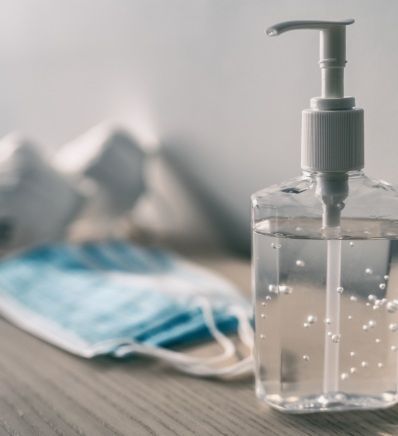Virus & Disease Prevention and You
From hand washing and food preparation to decontamination and quarantine, learn how you can do your part to stop the spread of disease at school, work, the hospital, and even at home.

With Coronavirus impacting our lives in new ways, students and healthcare professionals are asking themselves what can be done to prevent future pandemics. Because climate change, population growth, and antimicrobial resistance can make outbreaks tough to contain, our best line of defense against the next pandemic is prevention. And while the government plays a key role, disease prevention starts with us. From healthcare professionals and students to patients and everyday people, we can take important steps now to make our futures safer. Keep reading to learn how.
Communicable Diseases Best Practices Checklist
Communicable diseases best practices are essential in health promotion and disease prevention efforts. Healthcare professionals and the people they care about can follow these best practices at home, in healthcare settings, and in their everyday lives to stay healthy and help prevent the spread of communicable diseases.
In Healthcare Settings
- Hand Washing
You hear about hand washing a lot because it’s one of the most essential and effective disease prevention methods. Wash thoroughly with soap and water for at least 20 seconds, making sure to get between fingers and under nails. - Infection Control Precautions
Understand and carefully follow standard precautions and transmission precautions, like using PPE, practicing coughing and respiratory etiquette, and placing patients appropriately. - Decontamination Procedures
These procedures vary depending on the type of decontamination that needs to take place. Get familiar with common contamination issues in your field or department and the appropriate decontamination procedures for those issues. - Quarantine of Contacts
Quarantine those who have had contact with an infected person to limit the spread of disease. Those who are quarantined may not be infected but separating them from others to see if they get sick can reduce the public’s exposure to infection. - Prophylaxis of Exposed Individuals
Take preventive measures to protect those who may be exposed to infectious disease. For instance, prophylactic antibiotics can be used to prevent some bacterial infections rather than treat infections that have already occurred.
At Home
- Handle & Prepare Food Safely
Wash foods carefully, clean food prep areas before and after use, and make sure to cook meats at the recommended temperatures to avoid infection. Use airtight containers and refrigerate perishable foods. - Keep Hands Clean
Wash your hands for at least 20 seconds with antibacterial soap and rinse under warm water. Avoid touching the faucet or tap handles by using a towel to turn off the sink. - Clean & Disinfect Surfaces
High-use areas, like bathrooms and kitchens, should be cleaned and disinfected regularly. If you or someone in your house is sick, you may want to use an EPA certified disinfectant rather than plain soap and water to clean these areas. - Cough & Sneeze into a Tissue
While not always possible, coughing and sneezing into a disposable tissue is preferable to using your arm. If you know you’re sick, keep tissues with you so you can help prevent airborne and droplet transmissions. - Don’t Share Personal Items
Razors, toothbrushes, and other items that can’t be easily cleaned should not be shared between people. Don’t share bath towels between washes and never share needles. - Get Vaccinated
Staying on top of vaccines keeps many infections at bay. Getting vaccinated each season is the best way doctors currently know how to prevent the flu and there are many other vaccines out there to prevent infections that target people of different age groups and circumstances, so be sure you’re up to date on your vaccines. - Don’t Touch Wild Animals
Animals can carry a range of disease-causing germs, so be cautious. Make sure your pets avoid contact with wild animals and are up to date on their vaccinations. If you or your pet get bitten by a wild animal, contact your doctor or vet. - Stay Home When Ill
Prevent the spread of infectious disease by staying home if you get sick. Isolation gives you a chance to rest and keeps your illness from spreading to others.
Contagious Illness Awareness in Healthcare
Communicable disease best practices can be used to combat a slew of different illnesses, but healthcare workers may be more susceptible to certain infectious diseases than others. While typically mild if properly addressed, these diseases are easily spread around communal places such as college campuses and hospitals and deserve a special callout.
Viruses like SARS & Coronavirus
Severe Acute Respiratory Syndrome, or SARS, is a respiratory infection, like the flu. However, this infection is caused by coronaviruses rather than influenza viruses. Not all coronaviruses cause disease, but when they do, they can be difficult to contain, like with the 2003 SARS and 2020 COVID-19 outbreaks. Unlike flus, which can be predicted and avoided through vaccination, there is no coronavirus vaccine. Mild cases have symptoms similar to colds, so infection can be hard to detect. If you have cold or flu symptoms along with difficulty breathing, get a physical exam to see if you have a coronavirus infection. Wash your hands frequently and thoroughly to reduce your chances of getting infected and avoid those who have a coronavirus if possible.
Colds
Adults have 2-3 colds per year, on average. Colds are caused by viruses that spread through the air and through close contact with infected people. Runny nose, sore throat, coughing, sneezing, and achiness are common cold symptoms. There’s no cure for colds, but most people recover in about a week, sometimes with the help of symptom-relieving over-the-counter medication. The best way to avoid colds and protect people around you if you are infected is by washing your hands regularly, avoiding close contact with others, and disinfecting common areas. Also refrain from touching your face before washing your hands.
Flu
Flus are respiratory infections caused by influenza viruses. Flu symptoms are similar to cold symptoms, but they often come with a fever as well and may cause stomach upset. Flus are contagious and the best way to avoid contracting and spreading the flu is to get a flu shot each season. If you do get the flu, rest well, wash your hands, disinfect commonly used surfaces, and keep away from others to prevent spread. Most people who get the flu recover in under two weeks, but complications like sinus and ear infections or pneumonia can occur.
Gastroenteritis
Commonly known as stomach flu, gastroenteritis can be caused by a wide range of pathogens and toxins. Noroviruses are the most common cause of stomach flu and they are highly contagious. Keeping clean and washing your hands well is the best way to avoid gastroenteritis caused by norovirus.
Meningitis
Meningitis, swelling of the brain and spinal cord’s protective membrane, is typically caused by viral or bacterial infection, but may also have other causes, such as injury. If you have meningitis symptoms, it’s important to see a doctor right away so they can determine the cause and the best treatment. While viral meningitis is fairly common and often gets better on its own, bacterial meningitis is extremely serious and must be treated quickly. Meningitis symptoms include stiff neck, headache, confusion, dizziness, nausea, and skin rash.
Mononucleosis
“Mono” is an infectious disease most commonly caused by the Epstein-Barr virus (EBV). It’s also known as the kissing disease because it’s easily spread through saliva. Mono is most common among high school and college students and it can spread easily because the symptoms –fever, swollen lymph nodes in the neck and armpits, sore throat, achiness and enlarged spleen– typically don’t appear for 4-6 weeks after getting infected. There is no vaccine for mono, but most people recover in four weeks or less, however, fatigue can last longer. If you have mono, talk to a doctor to get specific treatment advice.
Tuberculosis
Tuberculosis, or TB, is a bacterial infection. Depending on where the bacteria settles, TB may or may not be infectious. If it attacks the lungs or throat, the bacteria can spread through coughing, sneezing, and speaking if a nearby person breathes it in. Kissing and sharing food does not spread TB. There are two types of TB: latent TB infection (LTBI), which does not cause infected people to get sick, and TB disease, which can be dangerous if left untreated.
The Healthcare Student’s Role in Contagious Disease Prevention
Just because healthcare students are still learning doesn’t mean they can’t play a vital role in preventing the spread of contagious diseases. Through direct action and education, students can actively engage in health promotion and disease prevention on campus, at home, and in the field.
Safety at School & On Campus
Healthcare students have a greater awareness of infectious disease than many of their peers, so their peers may look to them as accessible trusted authorities on health issues. Getting familiar with your school’s infectious disease response protocol can provide useful guidelines and help you educate peers and lead by example. Commit to safety basics like washing your hands between classes and paying extra attention to shared spaces. In a shared kitchen, for instance, others may not be as careful with cleaning as necessary, so be sure to sanitize before and after preparing food and clean common areas regularly.
You can also take advantage of health resources on campus and encourage your peers to do so as well. Student health centers offer advice and workshops on limiting the spread of illness and they provide services like infection treatment and flu shots, which are particularly important on college campuses. Flu vaccines are the most effective way to prevent the flu, but vaccination rates among college students are incredibly low. Around 46% say they typically get vaccinated, but actual annual vaccination rates among college students typically lie somewhere between 8% and 39% according to the National Foundation for Infectious Diseases. So, increasing the number of students getting vaccinated each year is crucial to disease and virus prevention on campuses.
Safety in a Healthcare Setting
Healthcare professionals have the dual responsibility of taking care of their patients while keeping themselves healthy as well. Especially in high-stress situations, like during the COVID-19 outbreak, healthcare workers should take care to slow down, even though it may be counterintuitive. Professionals should take the time to make sure they are following safety and sanitation guidelines, especially in areas they haven’t practiced much, like putting on and taking off safety gear.
Personal Protective Equipment (PPE), like gloves, masks, and face shields can greatly reduce healthcare workers exposure to infectious disease when used properly. However, studies indicate that even experienced medical professionals frequently contaminate themselves by removing PPE improperly. One study published in 2019 found that almost 40% of observed healthcare workers made errors in removing PPE. Learning how to safely and properly use PPE is a vital aspect of effectively diminishing the spread of disease in healthcare settings.
Safety at Home
Staying safe at home is just as important as at work and school. Wash your hands when you come home and find time to clean regularly. Protect yourself from sick housemates or family members by keeping a safe distance, washing your hands, and avoiding touching your eyes and mouth. You may want to disinfect your home more often if you or someone else is sick.
If your housemates aren’t taking health and safety precautions, remind them that you interact with sick people whose good health depends on yours. By putting themselves at risk, they are putting you and your patients at risk, too. Be gracious and teach them health and safety best practices. Put hand washing visuals by the sinks and encourage them to get vaccinated if they aren’t already. Need advice on persuading friends and family to get vaccinated? Check out our guide to vaccine advocacy and education.
Dos & Don’ts If You Get Sick
Do: Ask about the sick day expectations at your work or school. Some expect students and professionals to continue working through illness and assume they will follow appropriate health and safety protocol, like using PPE and washing their hands. Others have workers take time off to avoid inoculating at-risk patients.
Don’t: Make assumptions or guesses about taking sick days. It’s better to ask in advance of getting sick so you know what to expect and how to respond.
Do: If you’re in school, put in the work to get your lectures, notes, assignments, and tests in order. Like with clinicals, some schools expect students to work through illness while others explicitly request that students stay home. Communicate with the dean and your professors when you get sick and get a doctor’s note to help administration make your absence official. Use resources like a note taking service and mp3 recordings of lectures so you can stay on top of your work at home.
Don’t: Go to class or work if you can help it, as you’ll put classmates or coworkers at risk, but don’t let your work slip, either.
Do: Inform those around you of your illness and advise them on safety best practices.
Don’t: Put others at risk by downplaying your illness. Don’t overreact but be clear and straightforward about your condition and what it means to the people who spend time with you.
What Are Colleges Doing to Prevent the Spread of Illness?

Colleges can promote student wellness and reduce the spread of illness in a variety of ways, from posting engaging hand washing PSAs to offering in-depth coursework to students interested in disease prevention work.
College healthcare programs often have pages online dedicated to student wellness on campus. These pages provide information on a range of illnesses, including how to prevent them. Schools, like the University of Idaho and Michigan State University, for example, offer a range of wellbeing workshops, initiatives, events, and resources. Some colleges and healthcare departments work to engage the whole school in health and wellness challenges. For instance, colleges across New Jersey participate in a statewide flu challenge to improve vaccination rates among college students.
Students can also take advantage of health centers on campus. Many of these are run by different medical and healthcare departments around campus and can offer preventive care, treatment, flu shots, and information on disease prevention.
Some colleges, like the University of Indiana and Stanford University, offer specialized courses or degree concentrations that focus specifically on health promotion and disease prevention. Colleges may also conduct research on disease prevention and health promotion so students can help with hands-on research and specialize their knowledge. The University of Massachusetts, for example, offers a clinical and population health research program that allows students to work with faculty on different aspects of disease prevention and health promotion research.
Online Learning
Online learning can play a critical role in education in the event of an infectious disease outbreak. Whether there’s a particularly bad cold and flu season and students need to keep up with their classwork or there’s a public health emergency that shuts down campuses like the COVID-19 outbreak, being able to continue learning online is essential to student success and student health.
In the case of COVID-19, many schools were not prepared to make a full shift into online education which made for a challenging transition. Emergency planning and training in delivering courses online can help students and instructors stay on track, even when social distancing is necessary for public health.
Students may also consider earning their healthcare degrees online from the start. Health science, public health, and many other healthcare degree programs are available online, allowing students the flexibility they need should they get sick while in school.
Advice from an Infectious Disease Expert


Hannah Johnson works as a Clinical Research Coordinator in the Oregon Health & Science University’s Department of Trauma, Critical Care, and Acute Care Surgery. She obtained her Bachelor of Science from the Honors College at Portland State University and will start her Master of Public Health at the Icahn School of Medicine at Mount Sinai in Fall 2020. Having completed her undergraduate Honors Senior Thesis on Drug-Resistant Tuberculosis, she is excited to continue studying infectious disease by completing her Master of Public Health in the Global Health Track at Mount Sinai.
Q: What tips do you have for healthcare students who are trying to manage their coursework and/or clinicals while sick? How can they strike a balance, not fall behind, and keep others from getting sick as well?
A: I think the number one tip is to take care of yourself. If you’re sick, you should stay home. Going to class could prolong your illness and put your peers at risk. Communicate with your professors and do what you can. In the present, healthcare students are being taught more and more to value their own wellness. People burnout when they aren’t allowed the proper time and resources to manage an illness. We can’t be in the profession of teaching others to be well and not take care of ourselves.
Q: During public health emergencies, how might student roles change and how can students adjust to those changes?
At the hospital where I work, students are restricted from being in the hospital due to COVID-1. All nonessential staff is restricted from the hospital actually, and in situations where one person can do a job instead of multiple people, we have reduced our numbers to achieve this. Educational requirements aren’t worth the threat to student’s lives in the midst of a public health emergency. All classes are online and will continue online until we have deemed it safe for our students to return to school.
Q: What are some common misconceptions about catching, preventing or spreading disease that healthcare students should be aware of?
A common misconception that has, unfortunately, become more of an issue presently, is the relationship between stigma and disease. Most people are aware that the current pandemic started in Wuhan, China. What should be considered a simple fact is instead being turned on its head. People are using their knowledge of the source of the virus to enable expressions of hate and fear towards individuals of Asian descent. At a time where people need to band together and support one another, feeding into a culture of fear is the least helpful action people can take.
Q: What’s your best piece of advice for healthcare students looking for tips on disease prevention?
The first thing I do when I get home is wash my hands. Pandemic or not, good old soap and water are oftentimes the best defense against pesky microorganisms. Preventing those organisms from making their way onto the surfaces in your home will allow you some wiggle room to relax when you’re in your own space.
Additional Resources
American College Health Association (ACHA)
This national organization provides a wealth of information, resources, events, and educational materials to promote and support healthy college campuses.
AMA guiding principles to protect learners responding to COVID-19
The American Medical Association (AMA) offers some guidelines to consider when healthcare students may be needed in public health emergencies. These guidelines pertain specifically to COVID-19 response but raise interesting points students and schools can consider in various situations.
Health Promotion Materials | Handwashing
Healthcare students looking to promote handwashing awareness on campus and in their communities can find an array of fun and informative materials from the CDC.
How to Prevent Coronavirus Spread When You’re Living on Campus
While this article specifically addresses coronavirus, students can apply this advice to a range of infectious diseases.
Infection Prevention Control in Hospitals: Why Doctors and Nurses Don’t Get Sick More Often
Get an inside look into how doctors and nurses manage to stay on their feet despite the barrage of germs they face on a daily basis.
Infectious Diseases – National Foundation for Infectious Diseases
This page provides a ton of information to those looking to learn more about specific infectious diseases.
My roommate has the flu. What do I do now?
Shared living situations aren’t easy in the best of times and they can get extra tenuous when someone is sick. This piece from MIT offers advice to students living with a sick roommate.
Online learning during COVID-19: Tips to help med students succeed
If your healthcare curriculum moves online, these tips can help you make the most of your courses.
Sequences for Putting on and Removing Personal Protective Equipment (PPE)
This series of diagrams from the CDC can help students learn the right ways to take off and put on PPE.
The Student Doctor Network is a great resource for medical and healthcare students to connect with each other, ask questions, and discuss issues. Browse the forums to learn what other students are doing to prevent communicable diseases.


